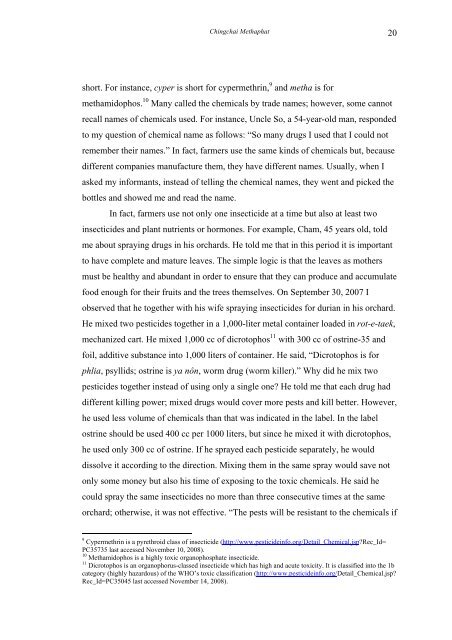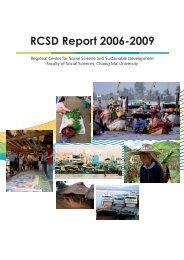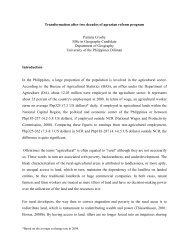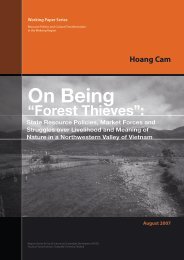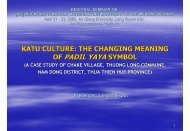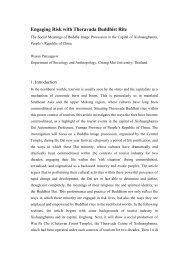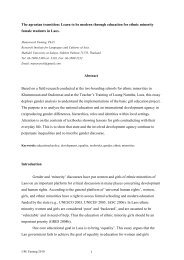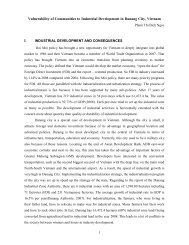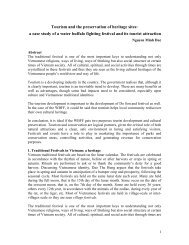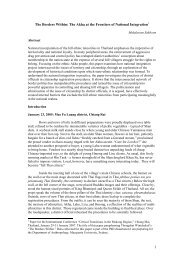Fruit Production and Distribution: Risks of Beautification and ... - RCSD
Fruit Production and Distribution: Risks of Beautification and ... - RCSD
Fruit Production and Distribution: Risks of Beautification and ... - RCSD
Create successful ePaper yourself
Turn your PDF publications into a flip-book with our unique Google optimized e-Paper software.
Chingchai Methaphat 20short. For instance, cyper is short for cypermethrin, 9 <strong>and</strong> metha is formethamidophos. 10 Many called the chemicals by trade names; however, some cannotrecall names <strong>of</strong> chemicals used. For instance, Uncle So, a 54-year-old man, respondedto my question <strong>of</strong> chemical name as follows: “So many drugs I used that I could notremember their names.” In fact, farmers use the same kinds <strong>of</strong> chemicals but, becausedifferent companies manufacture them, they have different names. Usually, when Iasked my informants, instead <strong>of</strong> telling the chemical names, they went <strong>and</strong> picked thebottles <strong>and</strong> showed me <strong>and</strong> read the name.In fact, farmers use not only one insecticide at a time but also at least twoinsecticides <strong>and</strong> plant nutrients or hormones. For example, Cham, 45 years old, toldme about spraying drugs in his orchards. He told me that in this period it is importantto have complete <strong>and</strong> mature leaves. The simple logic is that the leaves as mothersmust be healthy <strong>and</strong> abundant in order to ensure that they can produce <strong>and</strong> accumulatefood enough for their fruits <strong>and</strong> the trees themselves. On September 30, 2007 Iobserved that he together with his wife spraying insecticides for durian in his orchard.He mixed two pesticides together in a 1,000-liter metal container loaded in rot-e-taek,mechanized cart. He mixed 1,000 cc <strong>of</strong> dicrotophos 11 with 300 cc <strong>of</strong> ostrine-35 <strong>and</strong>foil, additive substance into 1,000 liters <strong>of</strong> container. He said, “Dicrotophos is forphlia, psyllids; ostrine is ya nôn, worm drug (worm killer).” Why did he mix twopesticides together instead <strong>of</strong> using only a single one? He told me that each drug haddifferent killing power; mixed drugs would cover more pests <strong>and</strong> kill better. However,he used less volume <strong>of</strong> chemicals than that was indicated in the label. In the labelostrine should be used 400 cc per 1000 liters, but since he mixed it with dicrotophos,he used only 300 cc <strong>of</strong> ostrine. If he sprayed each pesticide separately, he woulddissolve it according to the direction. Mixing them in the same spray would save notonly some money but also his time <strong>of</strong> exposing to the toxic chemicals. He said hecould spray the same insecticides no more than three consecutive times at the sameorchard; otherwise, it was not effective. “The pests will be resistant to the chemicals if9 Cypermethrin is a pyrethroid class <strong>of</strong> insecticide (http://www.pesticideinfo.org/Detail_Chemical.jsp?Rec_Id=PC35735 last accessed November 10, 2008).10 Methamidophos is a highly toxic organophosphate insecticide.11 Dicrotophos is an organophorus-classed insecticide which has high <strong>and</strong> acute toxicity. It is classified into the 1bcategory (highly hazardous) <strong>of</strong> the WHO’s toxic classification (http://www.pesticideinfo.org/Detail_Chemical.jsp?Rec_Id=PC35045 last accessed November 14, 2008).


